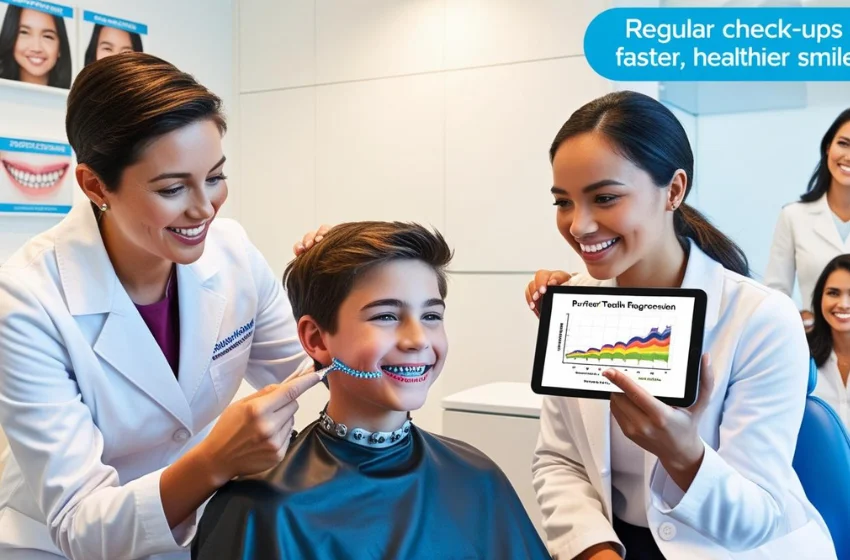The Importance of Regular Orthodontic Check-Ups
Orthodontic care plays a significant role in achieving a healthy, beautiful smile, but requires more than just wearing braces or aligners. The journey to optimal oral health involves regular check-ups with an orthodontist to monitor progress, address potential issues, and make adjustments to ensure effective treatment.
We will explore why these regular visits are essential for ensuring that your treatment progresses smoothly and protecting your overall dental health. Consistent check-ups help avoid complications, prevent dental issues, and guarantee long-term success in orthodontic treatment.
Why Regular Orthodontic Check-Ups Matter
Monitoring Progress and Adjusting Treatment
Orthodontic treatments often span months or years, depending on the severity of the dental issues being addressed. Regular check-ups are essential for monitoring treatment progress and making adjustments as needed. These appointments allow the orthodontist to evaluate the movement of your teeth and the alignment of your bite.
If any discrepancies arise, such as a delay in progress, uneven movement, or unexpected changes in the teeth, the orthodontist can intervene by adjusting the braces, changing the aligner trays, or suggesting alternative approaches. For both adult and kids ortho care in Duluth, staying on top of treatment modifications during these regular check-ups ensures that the treatment remains on schedule and that you achieve the attain treatment goals on schedule.
Preventing Dental Issues During Treatment
Orthodontic devices such as braces can sometimes contribute to dental problems if not closely monitored. Food can get caught in the brackets or between the teeth, creating an environment where plaque can build up. This plaque can lead to cavities, gum disease, or inflammation without regular check-ups. During these visits, the orthodontist can inspect the condition of your teeth and gums, ensuring no damage is caused by food buildup or poor hygiene practices. If there are early signs of tooth decay or gum issues, your orthodontist can provide treatments, cleaning, and guidance on properly caring for your braces. Preventing these issues helps maintain oral health and ensures that your treatment remains effective and free from delays.
Ensuring Comfort and Reducing Discomfort
As braces or aligners gradually move your teeth into their desired positions, they can cause discomfort or irritation. This is especially true after adjustments, where tightening wires or changing trays can create soreness in the teeth and gums. During your routine orthodontic visits, we can identify and resolve any treatment-related discomfort you might be feeling If the braces or aligners are causing pain due to misalignment, the orthodontist can adjust the wires, brackets, or tray fit to reduce discomfort. Additionally, these visits ensure that no part of the orthodontic appliance is digging into the gums or causing unnecessary irritation. Maintaining comfort throughout treatment encourages patient compliance and helps ensure the treatment proceeds as planned.
Tracking the Health of Teeth and Gums
Though the primary goal of orthodontic care is to correct tooth alignment, it significantly influences your overall oral health. Appliances apply targeted forces to teeth, which—without proper supervision—could lead to gum recession, increased sensitivity, or jaw discomfort. Through regular check-ups, orthodontists carefully assess gum tissue integrity and track how surrounding teeth adapt to treatment.
If there are signs of issues such as gum recession or tooth mobility, these concerns can be addressed before they become more serious. Furthermore, if teeth or gums show signs of infection or decay, the orthodontist can suggest the appropriate treatments to prevent further damage and preserve long-term dental health.
Evaluating Growth and Development in Younger Patients
Orthodontic check-ups are particularly important for children and adolescents as they are still growing. The growth of the jaw, teeth, and facial bones is a key consideration in orthodontic treatment, especially when dealing with misalignment or bite issues. Regular visits allow the orthodontist to monitor how the child’s teeth and jaw develop and if any adjustments need to be made to the treatment plan.
This is particularly true in cases where early intervention is recommended, such as when a child’s bite needs correction before the permanent teeth have fully erupted. These early visits can ensure that the orthodontist takes advantage of natural growth patterns to achieve the best possible results in a shorter time frame.
Ensuring the Aesthetic and Functional Goals of Treatment Are Met
Orthodontic treatment is not just about straightening teeth—it also aims to improve the function and aesthetics of a patient’s smile. Routine visits help guarantee successful treatment outcomes.During each visit, the orthodontist will assess how well the teeth align, the bite's functioning, and whether the patient is experiencing any difficulty with speaking, chewing, or smiling.
If any issues arise that may affect the final result, such as misaligned teeth or an improper bite, the orthodontist can adjust the treatment plan. These proactive measures ensure that the patient’s smile is straight and fully functional, which can significantly improve self-esteem and overall dental health in the long term.
Regular orthodontic check-ups are a vital aspect of orthodontic care that should never be overlooked. These appointments are critical in monitoring progress, preventing dental problems, and ensuring the treatment remains on track. By addressing any issues related to discomfort, the health of the gums and teeth, and overall alignment, orthodontic check-ups help patients achieve the desired results while minimizing complications.
Additionally, these visits ensure that growth patterns are monitored for children and adolescents, enabling the orthodontist to take advantage of natural development to achieve the best possible outcome. With regular check-ups, patients are more likely to experience a smooth treatment process and ultimately enjoy a beautiful, functional smile that lasts a lifetime.













